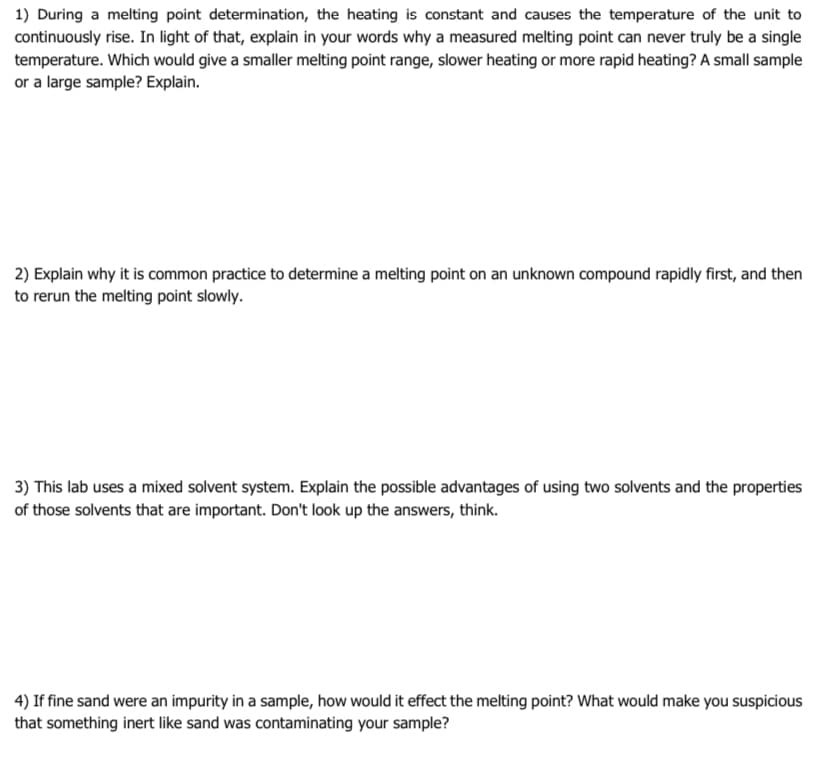1) During a melting point determination, the heating is constant and causes the temperature of the unit to continuously rise. In light of that, explain in your words why a measured melting point can never truly be a single temperature. Which would give a smaller melting point range, slower heating or more rapid heating? A small sample or a large sample? Explain.
1) During a melting point determination, the heating is constant and causes the temperature of the unit to continuously rise. In light of that, explain in your words why a measured melting point can never truly be a single temperature. Which would give a smaller melting point range, slower heating or more rapid heating? A small sample or a large sample? Explain.
Chemistry
10th Edition
ISBN:9781305957404
Author:Steven S. Zumdahl, Susan A. Zumdahl, Donald J. DeCoste
Publisher:Steven S. Zumdahl, Susan A. Zumdahl, Donald J. DeCoste
Chapter1: Chemical Foundations
Section: Chapter Questions
Problem 1RQ: Define and explain the differences between the following terms. a. law and theory b. theory and...
Related questions
Question
100%

Transcribed Image Text:1) During a melting point determination, the heating is constant and causes the temperature of the unit to
continuously rise. In light of that, explain in your words why a measured melting point can never truly be a single
temperature. Which would give a smaller melting point range, slower heating or more rapid heating? A small sample
or a large sample? Explain.
2) Explain why it is common practice to determine a melting point on an unknown compound rapidly first, and then
to rerun the melting point slowly.
3) This lab uses a mixed solvent system. Explain the possible advantages of using two solvents and the properties
of those solvents that are important. Don't look up the answers, think.
4) If fine sand were an impurity in a sample, how would it effect the melting point? What would make you suspicious
that something inert like sand was contaminating your sample?
Expert Solution
This question has been solved!
Explore an expertly crafted, step-by-step solution for a thorough understanding of key concepts.
This is a popular solution!
Trending now
This is a popular solution!
Step by step
Solved in 2 steps with 1 images

Follow-up Questions
Read through expert solutions to related follow-up questions below.
Follow-up Question
2) Explain why it is common practice to determine a melting point on an unknown compound rapidly first, and then to rerun the melting point slowly.
Solution
Recommended textbooks for you

Chemistry
Chemistry
ISBN:
9781305957404
Author:
Steven S. Zumdahl, Susan A. Zumdahl, Donald J. DeCoste
Publisher:
Cengage Learning

Chemistry
Chemistry
ISBN:
9781259911156
Author:
Raymond Chang Dr., Jason Overby Professor
Publisher:
McGraw-Hill Education

Principles of Instrumental Analysis
Chemistry
ISBN:
9781305577213
Author:
Douglas A. Skoog, F. James Holler, Stanley R. Crouch
Publisher:
Cengage Learning

Chemistry
Chemistry
ISBN:
9781305957404
Author:
Steven S. Zumdahl, Susan A. Zumdahl, Donald J. DeCoste
Publisher:
Cengage Learning

Chemistry
Chemistry
ISBN:
9781259911156
Author:
Raymond Chang Dr., Jason Overby Professor
Publisher:
McGraw-Hill Education

Principles of Instrumental Analysis
Chemistry
ISBN:
9781305577213
Author:
Douglas A. Skoog, F. James Holler, Stanley R. Crouch
Publisher:
Cengage Learning

Organic Chemistry
Chemistry
ISBN:
9780078021558
Author:
Janice Gorzynski Smith Dr.
Publisher:
McGraw-Hill Education

Chemistry: Principles and Reactions
Chemistry
ISBN:
9781305079373
Author:
William L. Masterton, Cecile N. Hurley
Publisher:
Cengage Learning

Elementary Principles of Chemical Processes, Bind…
Chemistry
ISBN:
9781118431221
Author:
Richard M. Felder, Ronald W. Rousseau, Lisa G. Bullard
Publisher:
WILEY